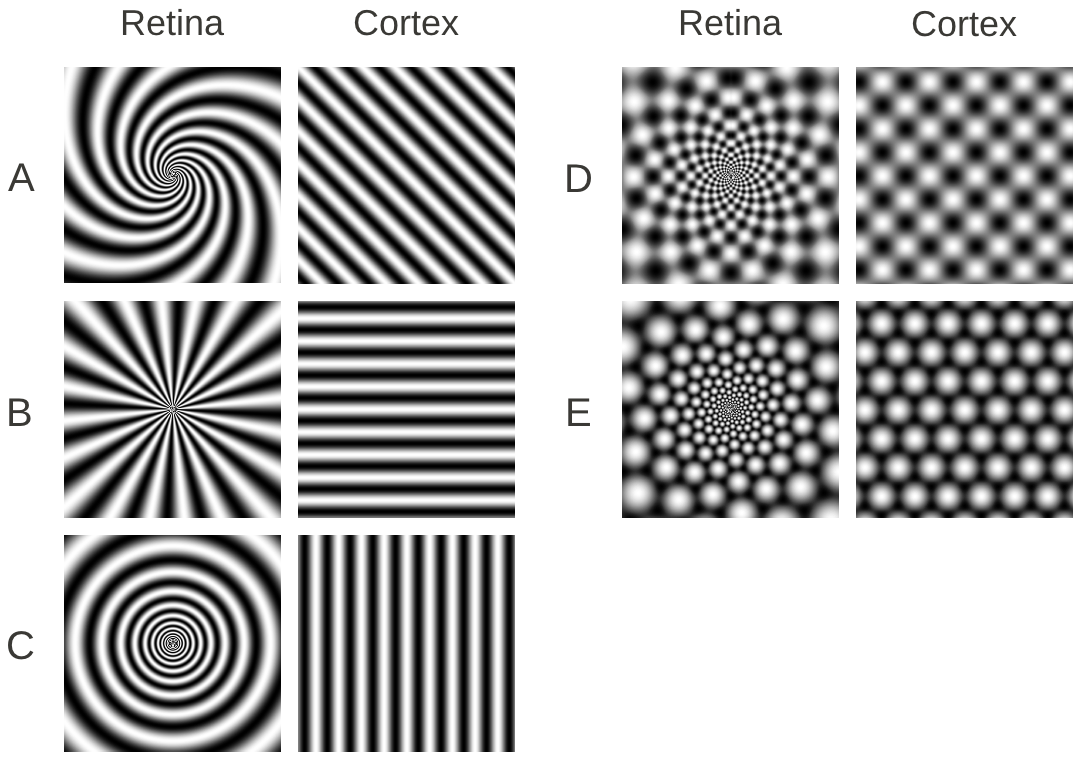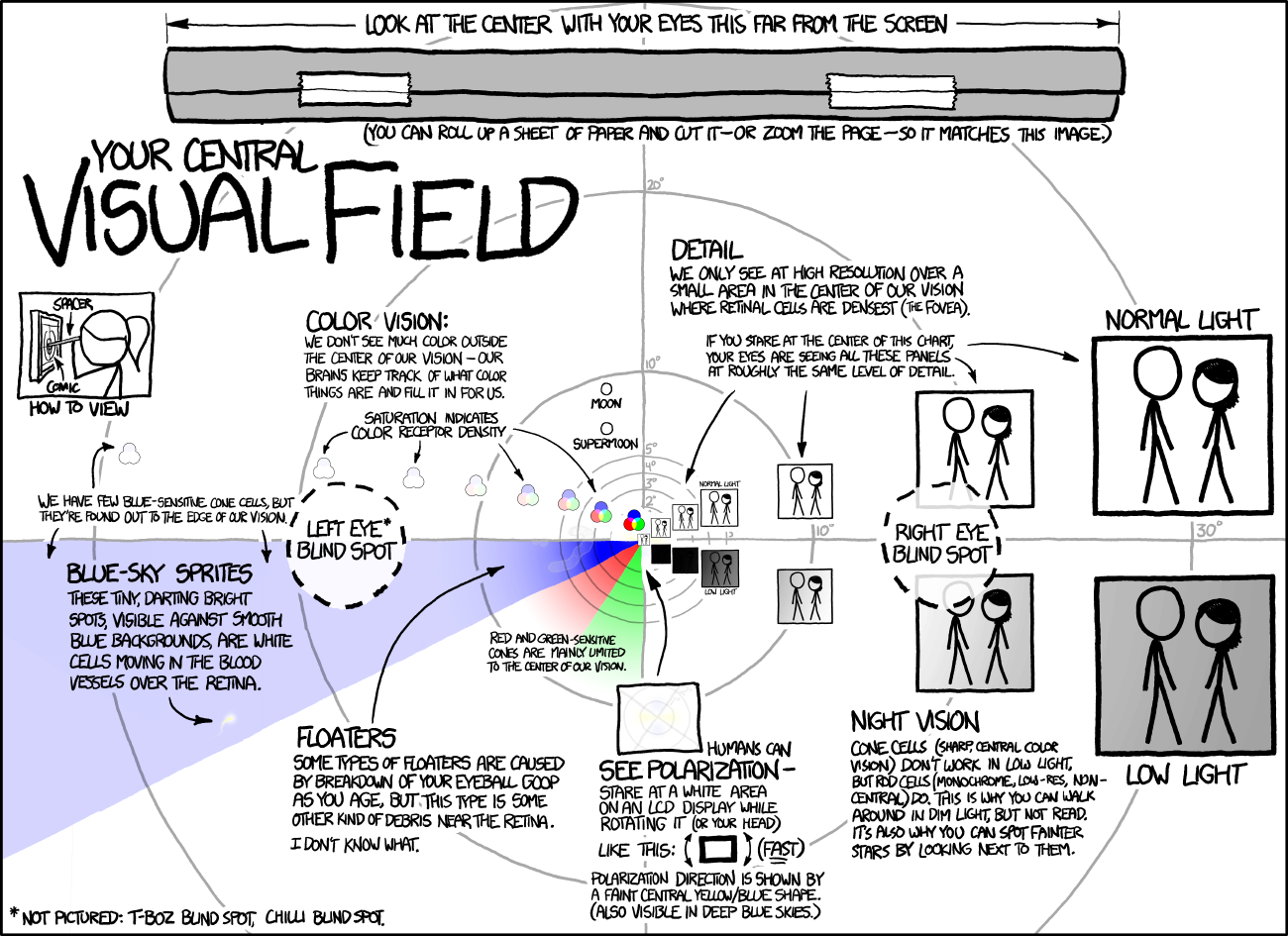source:
http://cosy.informatik.uni-bremen.de/si ... ly_13.html
Eye Movements
Several studies report the occurrence of spontaneous eye movements during mental imagery. These studies usually present participants with a stimulus which they later mentally imagine to describe or answer questions about. It is generally found that eye movements during such imagery tasks reflect the content of the mental image (e.g., Brandt & Stark, 1997; Spivey & Geng, 2001; Laeng & Teodorescu, 2002; Demarais & Cohen, 1998; Johansson, Holsanova, & Holmqvist, 2006; Johansson, Holsanova, Dewhurst, & Holmqvist, 2011).
In the experiments reported by Johansson et al. (2006) and Johansson, Holsanova, Dewhurst, and Holmqvist (2011), a distinction between local and global correspondence of eye movements to the processed content of the mental image is defined. Global correspondence requires that an eye movement is not only directed towards the expected direction, e.g., to the left when processing the spatial relation left of, but also to a location consistent with the participant’s gaze pattern over the whole experiment, i.e., the gaze is directed to the same location every time the same entity is referred to. Local correspondence requires the eye movement to only match the expected direction. Johansson et al. (2006) and Johansson, Holsanova, Dewhurst, and Holmqvist (2011) report experiments in which participants were either shown a complex and detailed picture or were presented with the verbal description of a complex and detailed scene. After this perception phase an imagery phase followed in which participants had to describe the picture/scene from memory while their eye movements were tracked. During this phase participants were facing a blank white screen. It was varied whether participants are allowed to freely move their eyes during the perception phase and during the imagery phase. For participants allowed to freely move their eyes during both phases, there is a significant local and global correspondence of their eye movements to the mental image. These results were reproduced in total darkness. The correspondence remained significant even when participants were forced to keep a fixed gaze during the perception phase. When participants had to keep a fixed gaze during the imagery phase after freely moving their eyes during the perception phase, it was found that recall is inhibited. Participants reported significantly less detail, objects, and locations compared to a control group. Furthermore, an analysis of the given verbal description showed that participants reported more abstract properties of the stimulus, e.g., global gestalt properties, whereas a control group reported more concrete details. These results provide evidence that eye movements during mental imagery are 1) functional for the recall of information from a mental image; 2) occur independently of the input modality of the stimulus; and 3) are not exact re-enactments of the eye movements of the visual perception of the stimulus.
Furthermore, it has been found that the spatial dispersion of eye movements during mental imagery depends on individual differences (Johansson, Holsanova, & Holmqvist, 2011). The spatial mental imagery score of the “Object-Spatial Imagery and Verbal Questionnaire” (Blazhenkova & Kozhevnikov, 2009) was found to be negatively correlated to the spatial dispersion of the gaze pattern produced during mental imagination of a complex scene. This spatial mental imagery score reflects a person’s preference and ability to use spatial mental imagery compared to, for example, visual mental imagery or language-like thought. Concretely, the spatial distribution of the eye movements, that is, the area participants looked at during imagery shrinks with higher scores in the ability to use spatial mental imagery.
Summarizing, the literature reports 1) the robust occurrence of spontaneous eye movements during mental imagery; 2) that these eye movements reflect the content of the mental image; 3) that forcing a fixed gaze affects mental imagery performance; and 4) that individual differences affect eye movements, in particular, their spatial dispersion
---
6.3 Eye Movements
As reviewed in Chapter 2, the literature reports the robust occurrence of spontaneous eye movements during mental imagery. These eye movements reflect the content of the mental image and have been shown to be functional in mental imagery. In particular, the recall of memories using mental imagery is negatively affected qualitatively and quantitatively when participants have to maintain a fixed gaze. Furthermore, individual differences in the spatial dispersion of such spontaneous eye movements have been reported.
6.3.1 Eye Movements in PIT
The computational model of PIT directly incorporates spontaneous eye movements during mental imagery because saccades are part of the perceptual actions used in visual perception. During mental imagery these same perceptual actions are employed to instantiate the conceptual description a mental image is based on. The model implements a distinction between overt and covert attention shifts. Overt attention shifts are assumed to correspond to, in particular, spontaneous eye movements, whereas covert attention shifts correspond to non-observable attention shifts such as within the periphery of one’s gaze. The distinction between overt and covert attention shifts is made based on the length of the vector that represents the attention shift. That is, vectors with a length larger than the a-priori set threshold, will be executed as overt attention shifts, i.e., eye movements. This means that if attention is shifted beyond a certain distance from the current focus of attention, the attention shift will be observable as a spontaneous eye movement.
6.3.2 Functionality of Eye Movements
In PIT, attention shifts are functional for mental imagery; they reflect the currently processed content and their suppression will restrict instantiation and thereby the generation and inspection of the mental image. These properties follow straight-forwardly from the fact that mental imagery is realized by the instantiation of mental concepts and that the process of instantiation is realized by employing perceptual actions such as (overt) attention shifts. If the spatial relation left-of is instantiated during mental imagery this could be realized by a respective eye movement which would then also directly reflect the currently imagined spatial relation. If eye movements are suppressed then consequently instantiation is inhibited. This means that the processing of the mental image is inhibited in so far as overt attention shifts cannot be executed. This will restrict the generation and inspection of the mental image. It has been shown that keeping a fixed gaze during mental imagery produces such inhibitions in recalling content of the mental image independent of how the to-be-imagined stimulus has been presented previously, i.e., verbally or visually. This finding is in line with PIT’s assumption that the mental concepts underlying mental images are the result of the integration of all modalities. That is, the instantiation is not directly related to the mode of perception of the to-be-instantiated mental concept.
Another aspect of the inhibition of mental imagery due to keeping a fixed gaze is the fact that not only the amount of information, e.g., the number of recalled entities of the stimulus, is decreased, but, additionally, also the quality of what is recalled, i.e., the type of information, changes when eye movements are inhibited. Johansson, Holsanova, Dewhurst, and Holmqvist (2011) reported that participants would rather recall global and more abstract information about the stimulus such as “it was a living room” or “the walls were colored in blue” when gaze was kept fixed during imagery. In contrast, the descriptions given in the condition in which eyes could move freely rather referred to referents, states and events of the stimulus, e.g., “the man was digging”. It is pointed out that the former more global information would also be expected to be perceived during visual perception with a fixed gaze, because it refers to the type of information that can be gathered through a single fixation and the surrounding peripheral information. This exact analogy between (fixed gaze) vision and (fixed gaze) imagery is also found in the computational model. An eye movement (i.e., an overt attention shift) is employed exactly when attention is to be shifted beyond what would be accessible by covert attention shifts. This means, the model could also only instantiate that information that requires no such overt attention shifts in a simulation of a fixed gaze mental imagery task. That information would then naturally be of the kind reported for fixed gaze vision, i.e., rather global and abstract information.
6.3.3 Individual Differences in Eye Movements
The dispersion of spontaneous eye movements during mental imagery is subject to individual differences and has been linked to the participants’ score in the “Object Spatial Imagery and Verbal Questionnaire” (OSIVQ) of Blazhenkova and Kozhevnikov (2009). This questionnaire assesses individual differences in cognitive style with respect to one’s ability and preference to use object imagery (i.e., visual mental imagery) and spatial mental imagery. The two scores for object and spatial mental imagery are negatively correlated to each other which indicates a trade-off between the two types of mental imagery (Kozhevnikov, Blazhenkova, & Becker, 2010). Johansson, Holsanova, and Holmqvist (2010) report a negative correlation between the spatial dispersion of eye movements during mental imagery and the spatial mental imagery score of the OSIVQ. That is, the stronger the preference/ability of a person to use spatial mental imagery, the lower the dispersion of spontaneous eye movements will be. There are two ways to account for this finding that can be derived from the model of PIT. The first possibility is that people with a preference to use spatial mental imagery have the skill of using spatial mental imagery very efficiently. Such efficiency could be understood as being able to instantiate spatial mental concepts, such as spatial relations, with particularly short attention shifts. That is, the concept left-of would be instantiated by a shorter vector by a participant with a high spatial mental imagery score than for a participant with a lower spatial mental imagery score. The shorter the vectors used in the instantiation process, the faster one can imagine spatial configurations, because reaction times depend on the length of the attention shift. This aids one’s ability (and thereby likely also one’s preference) to use spatial mental imagery. Shorter attention shifts naturally lead to a lower dispersion of the overall pattern of (overt) attention shifts.
The second possibility offered by the model is that people with a high spatial mental imagery score will mentally imagine much less visual information, e.g., shapes, textures, than a person with a low spatial imagery score. The reason is that the spatial mental imagery score is negatively correlated with the object (i.e., visual) imagery score which indicates the preference/ability to imagine visual information. When less shape information is instantiated, the instantiation of the spatial relations will in consequence utilize shorter attention shifts. The reason is that the instantiation of, for example, left-of is context-sensitive so that available perceptual information of the shape of a referenced entity will affect the length of the vector of left-of proportional to the extent of the entity’s (imagined) shape. Section 3.2.2 and Section 5.1.3 elaborate on the mechanisms of this context-sensitivity. Concretely, when the shape of an entity is not instantiated, its shape is abstracted to a point with no extent. For such a shape-less entity the length of the spatial relations is not affected so that the default short length is used. This property of the model can be observed in Figure 6.4. Table 6.3 shows a comparison of the employed overt and covert attention shifts for the two conditions.
------------------------------------
Numerous recent experimental studies have shown that, when people hold a visual image in mind, they spontaneously and unconsciously make saccadic eye movements that (at least partially) enact the stimulus-specific pattern of such movements that they would make if actually looking at the equivalent visual stimulus (Brandt & Stark, 1997; Demarais & Cohen, 1998; Spivey et al., 2000; Spivey & Geng, 2001; Gbadamosi & Zangemeister, 2001; Laeng & Teodorescu, 2002; de’Sperati, 2003; Johansson et al., 2005, 2006, 2010, 2012; Humphrey & Underwood, 2008; Holšánová, 2010; Holšánová et al., 2010; Sima et al., 2010; Bourlon et al., 2011; Fourtassi et al., 2011, 2013; Johansson, 2013; Johansson & Johansson, 2014; Laeng et al., 2014; see also Clark, 1916; Jacobson, 1932; Totten, 1935; Altmann, 2004; Martarelli & Mast, 2011).
Furthermore, imagery is disrupted (to a greater or lesser degree) if someone who is holding an image in their mind either restrains themselves (to the limited degree that this is possible) from making eye movements, or else deliberately moves their eyes in an image-irrelevant way, thus disrupting the spontaneous saccadic pattern (Antrobus et al., 1964; Singer & Antrobus, 1965; Sharpley et al., 1996; Andrade et al., 1997; Ruggieri, 1999; van den Hout et al., 2001, 2011; Kavanagh et al., 2001; Laeng & Teodorescu, 2002; Barrowcliff et al., 2004; Postle et al., 2006; Kemps & Tiggemann, 2007; Maxfield et al., 2008; Lee & Drummond, 2008; Gunter & Bodner, 2008; Lilley et al., 2009; Jonikaitis et al., 2009; Engelhard et al., 2010, 2011; Laeng et al., 2014). This issue has been much researched lately, not so much because of its significance for our understanding of imagery, but because of its possible relevance to the understanding of the psychotherapeutic technique known as EMDR (Eye Movement Desensitization and Reprocessing), which is widely used in the treatment of Post-Traumatic Stress Disorder (PTSD), and which may perhaps owe its effectiveness largely to the fact that deliberate eye movements tend to disrupt any concurrent imagery. In EMDR treatment, patients are induced to deliberately move their eyes back and forth whilst visually recalling the events that have traumatized them; it is claimed that this leads to a significant reduction in the vividness of their memories of those events, and of the distress, and consequent symptoms, that those memories cause (Shapiro, 1989a, 1989b, 2001; Shapiro & Forrest, 1997; Mollon, 2005). Studies of therapeutic outcomes seem to bear out claims for EMDR’s effectiveness (Carlson et al., 1998; Van Etten & Taylor, 1998; Shepherd et al., 2000; Power et al., 2002; Ironson et al., 2002; Bradley et al., 2005; APA, 2006; Bisson et al., 2007; Högberg et al., 2007, 2008; van der Kolk et al., 2007; Rodenburg et al., 2009; Kemp et al., 2010).
Although the mechanisms and real therapeutic effectiveness of EMDR remain controversial (for negative opinions, see: Lohr et al., 1998, 1999; McNally, 1999; Herbert et al., 2000; Davidson & Parker, 2001; Taylor et al., 2003; Justman, 2011; – for defenses and more positive assessments see: Perkins & Rouanzoin, 2002; Schubert & Lee, 2009; Gunter & Bodner, 2009; Cukor et al., 2010), the disruptive effect of deliberate eye movement upon visual imagery appears to be well established, and it implies that the eye movements that spontaneously occur when people visualize things (or, at the least, the brain processes that initiate and control these movements) are not mere accompaniments or epiphenomena of the imagery, but are (as enactive theory would lead one to expect) a true, functionally significant part of the physiological process that embodies it.[46] (However, Mast & Kosslyn (2002b) argue that the eye-movement evidence can also be accommodated to quasi-pictorial theory.[47])
























